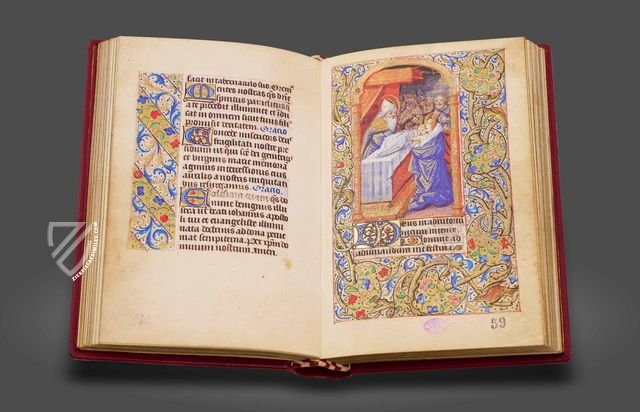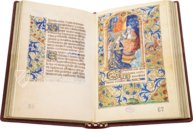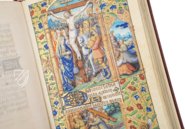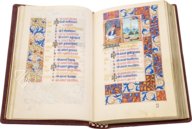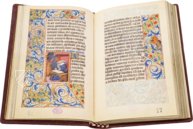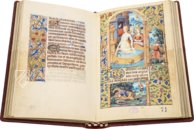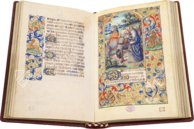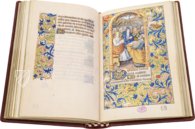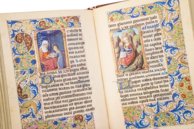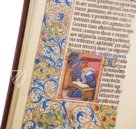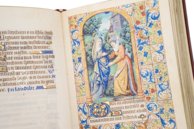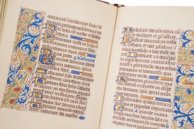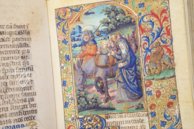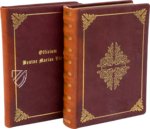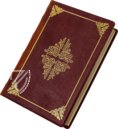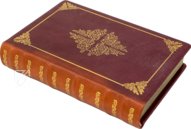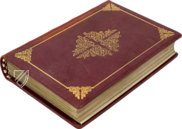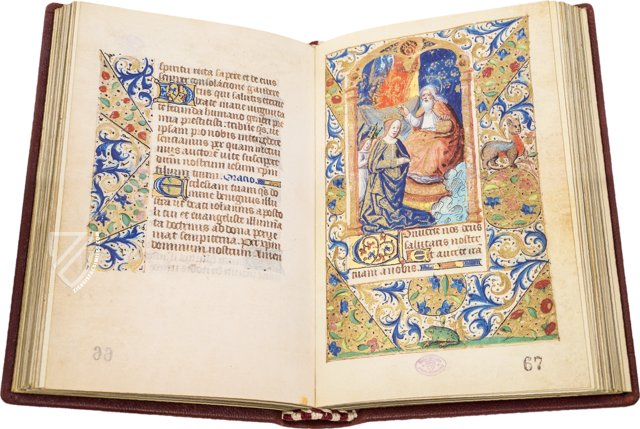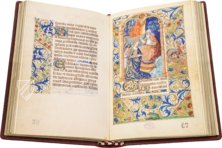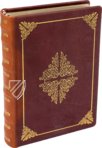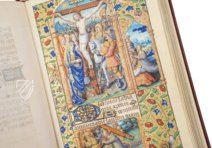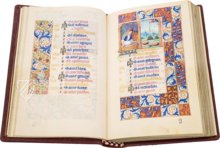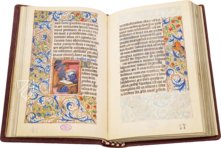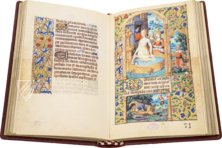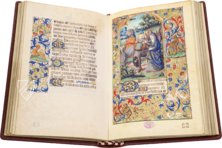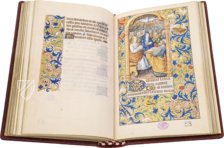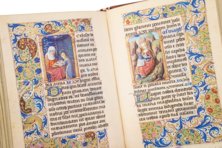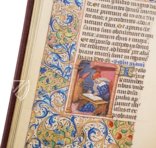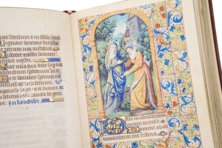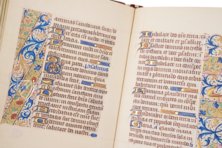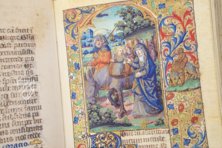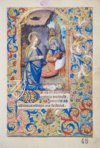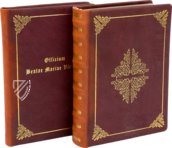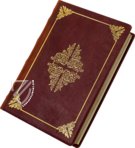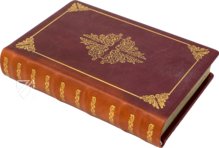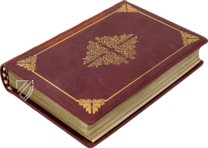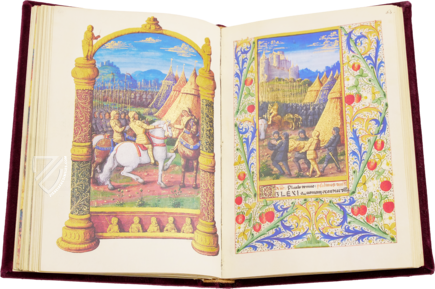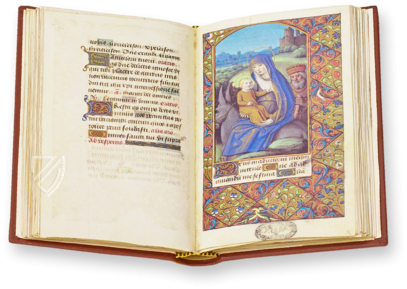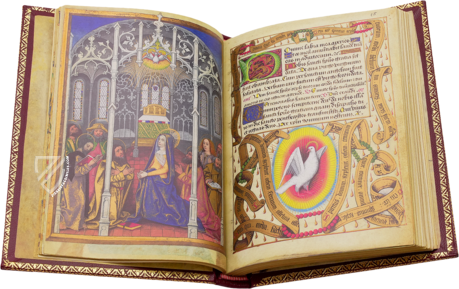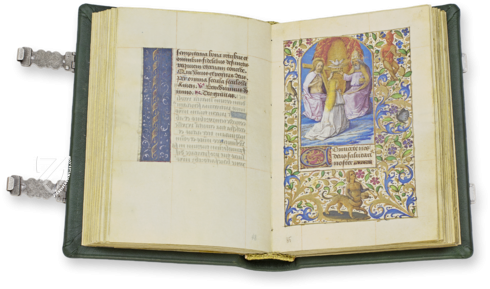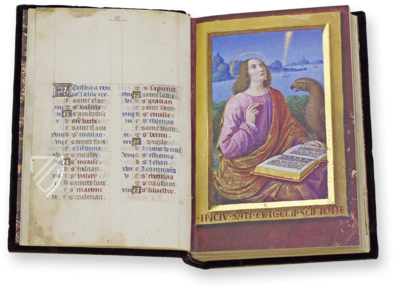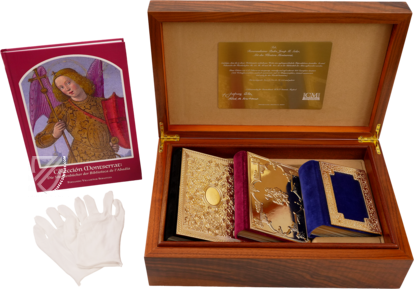Officium Beatae Virginis
(3,000€ - 7,000€)
A fine specimen of the golden age of French illumination: the Officium Beatae Virginis from the hand of the great master Jean Bourdichon (1457/59–1521). Bourdichon was one of the leading artists of his day and favorite of the French royal court, completing commissions for high ranking officials and members of the royal family, including four French kings. In this splendid book of hours from around the turn of the 16th century, the Little Office of Our Lady, a cycle of psalms, hymns, scripture, and other readings forming a liturgical devotion to the Virgin Mary, takes center stage. The text is adorned with the detailed miniatures and lavish frames one would expect from one of the greatest representatives of medieval art. Such is the quality of the adornment that it was the personal possession of Pope Pius VII (1742–1823) before making its way to Cava Abbey in southern Italy, where it resides today.
Officium Beatae Virginis
The book of hours, a prayer book consisting of the prayers to be recited at predetermined hours throughout the day and night, was the most popular book genre of the Late Middle Ages and more of these codices have survived to the present than any other. This French book of hours, the Officium Beatae Virginis emerged around the turn of the 16th century, when French illumination was enjoying a golden age. It originated from one of the greatest representatives of that artistic epoch, Jean Bourdichon (1457/59–1521), who learned his trade as an apprentice to Jean Fouquet (1420–81), the preeminent French painter of the 15th century. Both were from Tours and both were favored artists at the French royal court, completing commissions at the behest of high court officials and members of the royal family. Bourdichon enjoyed a long and productive career, creating works of art for kings Louis IX (1423–83), Charles VIII (1470–98), Louis XII (1462–1515), and Francis I (1494–1547). This splendid manuscript features masterful miniatures set in wide, richly embellished frames rendered in an incredible color palette and represents one of the finest specimens of a book of hours dedicated to the Virgin Mary.
Hours of the Virgin
Also known as the Little Office of Our Lady, it is a cycle of psalms, hymns, scripture, and other readings forming a liturgical devotion to the Virgin Mary. It originated around the mid–8th century and serves as a supplement to the Divine Office, also known as the Liturgy of the Hours, which consists of the official prayers “marking the hours of each day and sanctifying the day with prayer”. Already common by the end of the first millennium, multiple versions emerged in the years to follow. These prayers were often lavishly decorated and presented in a book of hours like the one here at hand and were usually created for the personal use of wealthy laymen. The Hours of the Virgin often appear alongside the Divine Office, but take center stage in the manuscript at hand.
Journey to Cava Abbey
La Trinità della Cava is a Benedictine abbey located in a gorge in the province of Salerno, Italy founded by St. Alferius (930–1050) in the year 1011. However, the abbey’s roots go back even deeper, both historically and literally because hermits had been living in the caves of the area since the 980’s. The abbey’s buildings were updated at the end of the 18th century and continue to exist in their sublime baroque style today. Our Officium Beatae Virginis is counted among the most prized possessions of La Trinità della Cava, and has called the abbey home since the 19th century. The whereabouts of the manuscript during the first few centuries of its existence remain unknown, but between 1840 and 1844, the codex was acquired by a certain Abbot Marincola for the private library of Pope Pius VII (1742–1823). The coveted codex was thereafter transferred to the possession of the abbey where it is housed as a special gem of their collections today.
Codicology
- Alternative Titles
- Officium Beatae Virginis - Cod. Cavense 47
Codex Cavense 47 - Origin
- France
- Date
- 15th century – 16th century
- Epochs
- Style
- Genre
- Language
- Content
- Book of Hours
- Artist / School
- Jean Bourdichon
Jean Fouquet - Previous Owners
- Pope Pius VII
Officium Beatae Virginis
January
From the lowliest peasant to the mightiest warlord, there was not much to do in the dead of winter during the Middle Ages except for eat, drink, and wait for the coming of spring. As a result, this labor of the month for January usually shows no labor but rather a richly dressed nobleman sitting in front of a fire with a cup of wine in his hand and a plate of food before him. On the other side of a golden column, a naked youth pouring out a jug of water represents the zodiac symbol Aquarius.
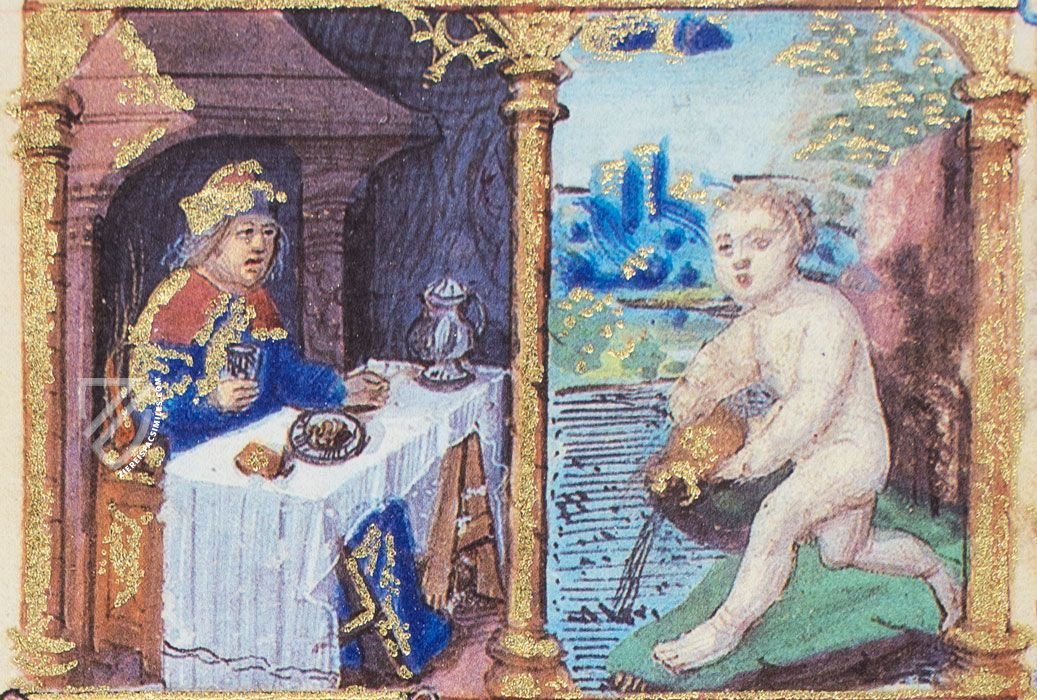
Officium Beatae Virginis
Flight to Egypt
After the visit of the Three Magi, Joseph receives a divine warning regarding King Herod. “Now when they had departed, behold, an angel of the Lord appeared to Joseph in a dream, saying, ‘Arise, take the young Child and His mother, flee to Egypt, and stay there until I bring you word; for Herod will seek the young Child to destroy Him.’” (Matt. 2:13)
Mary and Joseph walk alongside the donkey carrying the baby Jesus and all three members of the Holy Family are adorned with halos. The fall of folds of Mary’s dress is highlighted with delicate strokes of gold ink. The splendid floral frame of the manuscript depicts two monkeys, one on the right riding on the back of a pig and another at the bottom swinging a small dragon by its tail.
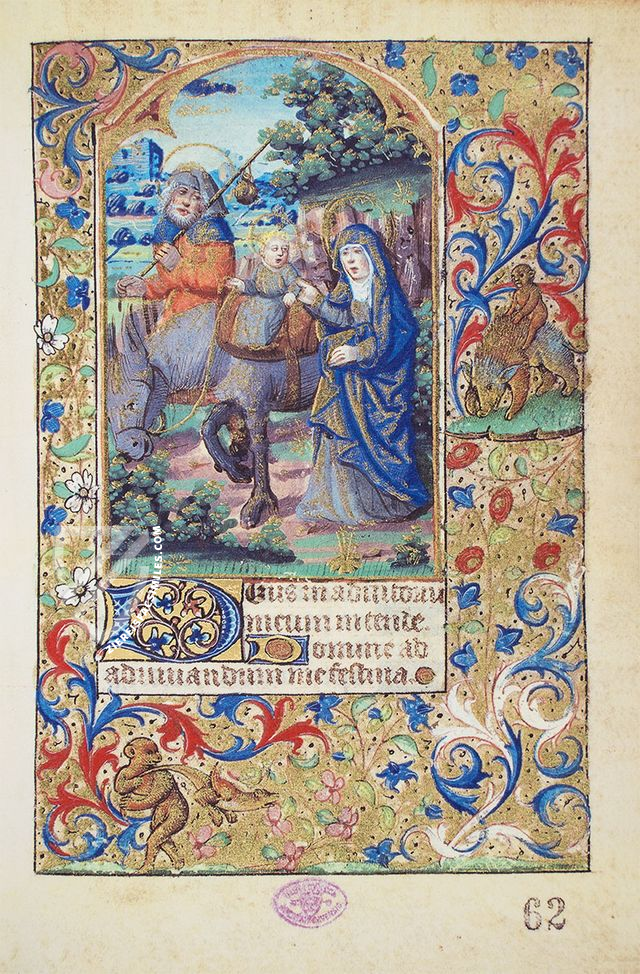
#1 Officium Beatae Virginis - Cod. Cavense 47
Language: Italian
(3,000€ - 7,000€)
- Treatises / Secular Books
- Apocalypses / Beatus
- Astronomy / Astrology
- Bestiaries
- Bibles / Gospels
- Chronicles / History / Law
- Geography / Maps
- Saints' Lives
- Islam / Oriental
- Judaism / Hebrew
- Single Leaf Collections
- Leonardo da Vinci
- Literature / Poetry
- Liturgical Manuscripts
- Medicine / Botany / Alchemy
- Music
- Mythology / Prophecies
- Psalters
- Other Religious Books
- Games / Hunting
- Private Devotion Books
- Other Genres
- Afghanistan
- Armenia
- Austria
- Belgium
- Belize
- Bosnia and Herzegovina
- China
- Colombia
- Costa Rica
- Croatia
- Cyprus
- Czech Republic
- Denmark
- Egypt
- El Salvador
- Ethiopia
- France
- Germany
- Greece
- Guatemala
- Honduras
- Hungary
- India
- Iran
- Iraq
- Israel
- Italy
- Japan
- Jordan
- Kazakhstan
- Kyrgyzstan
- Lebanon
- Liechtenstein
- Luxembourg
- Mexico
- Morocco
- Netherlands
- Palestine
- Panama
- Peru
- Poland
- Portugal
- Romania
- Russia
- Serbia
- Spain
- Sri Lanka
- Sweden
- Switzerland
- Syria
- Tajikistan
- Turkey
- Turkmenistan
- Ukraine
- United Kingdom
- United States
- Uzbekistan
- Vatican City
- A. Oosthoek, van Holkema & Warendorf
- Aboca Museum
- Ajuntament de Valencia
- Akademie Verlag
- Akademische Druck- u. Verlagsanstalt (ADEVA)
- Aldo Ausilio Editore - Bottega d’Erasmo
- Alecto Historical Editions
- Alkuin Verlag
- Almqvist & Wiksell
- Amilcare Pizzi
- Andreas & Andreas Verlagsbuchhandlung
- Archa 90
- Archiv Verlag
- Archivi Edizioni
- Arnold Verlag
- ARS
- Ars Magna
- ArtCodex
- AyN Ediciones
- Azimuth Editions
- Badenia Verlag
- Bärenreiter-Verlag
- Belser Verlag
- Belser Verlag / WK Wertkontor
- Benziger Verlag
- Bernardinum Wydawnictwo
- BiblioGemma
- Biblioteca Apostolica Vaticana (Vaticanstadt, Vaticanstadt)
- Bibliotheca Palatina Faksimile Verlag
- Bibliotheca Rara
- Boydell & Brewer
- Bramante Edizioni
- Bredius Genootschap
- Brepols Publishers
- British Library
- C. Weckesser
- Caixa Catalunya
- Canesi
- CAPSA, Ars Scriptoria
- Caratzas Brothers, Publishers
- Carus Verlag
- Casamassima Libri
- Centrum Cartographie Verlag GmbH
- Chavane Verlag
- Christian Brandstätter Verlag
- Circulo Cientifico
- Club Bibliófilo Versol
- Club du Livre
- CM Editores
- Collegium Graphicum
- Collezione Apocrifa Da Vinci
- Comissão Nacional para as Comemorações dos Descobrimentos Portugueses
- Coron Verlag
- Corvina
- CTHS
- D. S. Brewer
- Damon
- De Agostini/UTET
- De Nederlandsche Boekhandel
- De Schutter
- Deuschle & Stemmle
- Deutscher Verlag für Kunstwissenschaft
- DIAMM
- Droz
- E. Schreiber Graphische Kunstanstalten
- Ediciones Boreal
- Ediciones Grial
- Ediclube
- Edições Inapa
- Edilan
- Editalia
- Edition Deuschle
- Edition Georg Popp
- Edition Leipzig
- Edition Libri Illustri
- Editiones Reales Sitios S. L.
- Éditions de l'Oiseau Lyre
- Editions Medicina Rara
- Editorial Casariego
- Editorial Mintzoa
- Editrice Antenore
- Editrice Velar
- Edizioni Edison
- Egeria, S.L.
- Eikon Editores
- Electa
- Emery Walker Limited
- Enciclopèdia Catalana
- Eos-Verlag
- Ephesus Publishing
- Ernst Battenberg
- Eugrammia Press
- Extraordinary Editions
- Fackelverlag
- Facsimila Art & Edition
- Facsimile Editions Ltd.
- Facsimilia Art & Edition Ebert KG
- Faksimile Verlag
- Feuermann Verlag
- Folger Shakespeare Library
- Franco Cosimo Panini Editore
- Friedrich Wittig Verlag
- Fundación Hullera Vasco-Leonesa
- G. Braziller
- Gabriele Mazzotta Editore
- Gebr. Mann Verlag
- Gesellschaft für graphische Industrie
- Getty Research Institute
- Giovanni Domenico de Rossi
- Giunti Editore
- Graffiti
- Grafica European Center of Fine Arts
- Guido Pressler
- Guillermo Blazquez
- Gustav Kiepenheuer
- H. N. Abrams
- Harrassowitz
- Harvard University Press
- Helikon
- Hendrickson Publishers
- Henning Oppermann
- Herder Verlag
- Hes & De Graaf Publishers
- Hoepli
- Holbein-Verlag
- Houghton Library
- Hugo Schmidt Verlag
- Idion Verlag
- Il Bulino, edizioni d'arte
- ILte
- Imago
- Insel Verlag
- Insel-Verlag Anton Kippenberger
- Instituto de Estudios Altoaragoneses
- Instituto Nacional de Antropología e Historia
- Introligatornia Budnik Jerzy
- Istituto dell'Enciclopedia Italiana - Treccani
- Istituto Ellenico di Studi Bizantini e Postbizantini
- Istituto Geografico De Agostini
- Istituto Poligrafico e Zecca dello Stato
- Italarte Art Establishments
- Jan Thorbecke Verlag
- Johnson Reprint Corporation
- Josef Stocker
- Josef Stocker-Schmid
- Jugoslavija
- Karl W. Hiersemann
- Kasper Straube
- Kaydeda Ediciones
- Kindler Verlag / Coron Verlag
- Kodansha International Ltd.
- Konrad Kölbl Verlag
- Kurt Wolff Verlag
- La Liberia dello Stato
- La Linea Editrice
- La Meta Editore
- Lambert Schneider
- Landeskreditbank Baden-Württemberg
- Leo S. Olschki
- Les Incunables
- Liber Artis
- Library of Congress
- Libreria Musicale Italiana
- Lichtdruck
- Lito Immagine Editore
- Lumen Artis
- Lund Humphries
- M. Moleiro Editor
- Maison des Sciences de l'homme et de la société de Poitiers
- Manuscriptum
- Martinus Nijhoff
- Maruzen-Yushodo Co. Ltd.
- MASA
- Massada Publishers
- McGraw-Hill
- Metropolitan Museum of Art
- Militos
- Millennium Liber
- Müller & Schindler
- Nahar - Stavit
- Nahar and Steimatzky
- National Library of Wales
- Neri Pozza
- Nova Charta
- Oceanum Verlag
- Odeon
- Orbis Mediaevalis
- Orbis Pictus
- Österreichische Staatsdruckerei
- Oxford University Press
- Pageant Books
- Parzellers Buchverlag
- Patrimonio Ediciones
- Pattloch Verlag
- PIAF
- Pieper Verlag
- Plon-Nourrit et cie
- Poligrafiche Bolis
- Presses Universitaires de Strasbourg
- Prestel Verlag
- Princeton University Press
- Prisma Verlag
- Priuli & Verlucca, editori
- Pro Sport Verlag
- Propyläen Verlag
- Pytheas Books
- Quaternio Verlag Luzern
- Reales Sitios
- Recht-Verlag
- Reichert Verlag
- Reichsdruckerei
- Reprint Verlag
- Riehn & Reusch
- Roberto Vattori Editore
- Rosenkilde and Bagger
- Roxburghe Club
- Salerno Editrice
- Saltellus Press
- Sandoz
- Sarajevo Svjetlost
- Schöck ArtPrint Kft.
- Schulsinger Brothers
- Scolar Press
- Scrinium
- Scripta Maneant
- Scriptorium
- Shazar
- Siloé, arte y bibliofilia
- SISMEL - Edizioni del Galluzzo
- Sociedad Mexicana de Antropología
- Société des Bibliophiles & Iconophiles de Belgique
- Soncin Publishing
- Sorli Ediciones
- Stainer and Bell
- Studer
- Styria Verlag
- Sumptibus Pragopress
- Szegedi Tudomànyegyetem
- Taberna Libraria
- Tarshish Books
- Taschen
- Tempus Libri
- Testimonio Compañía Editorial
- Thames and Hudson
- The Clear Vue Publishing Partnership Limited
- The Facsimile Codex
- The Folio Society
- The Marquess of Normanby
- The Richard III and Yorkist History Trust
- Tip.Le.Co
- TouchArt
- TREC Publishing House
- TRI Publishing Co.
- Trident Editore
- Tuliba Collection
- Typis Regiae Officinae Polygraphicae
- Union Verlag Berlin
- Universidad de Granada
- University of California Press
- University of Chicago Press
- Urs Graf
- Vallecchi
- Van Wijnen
- VCH, Acta Humaniora
- VDI Verlag
- VEB Deutscher Verlag für Musik
- Verlag Anton Pustet / Andreas Verlag
- Verlag Bibliophile Drucke Josef Stocker
- Verlag der Münchner Drucke
- Verlag für Regionalgeschichte
- Verlag Styria
- Vicent Garcia Editores
- W. Turnowski Ltd.
- W. Turnowsky
- Waanders Printers
- Wiener Mechitharisten-Congregation (Wien, Österreich)
- Wissenschaftliche Buchgesellschaft
- Wissenschaftliche Verlagsgesellschaft
- Wydawnictwo Dolnoslaskie
- Xuntanza Editorial
- Zakład Narodowy
- Zollikofer AG

